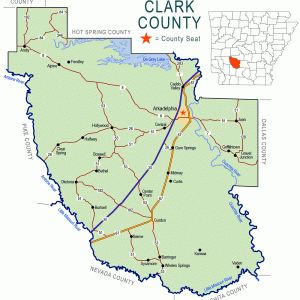calsfoundation@cals.org
Clear Spring (Clark County)
Clear Spring was a community that existed in western Clark County in the nineteenth and twentieth centuries. It was located about four miles east of Antoine (Pike County). It is often referred to as Clear Springs.
One of the earliest families in the area was the Meeks family, who arrived from Tennessee via Independence County in 1840. Other settlers soon arrived, and a school opened in the area. The Clear Springs Post Office operated from 1856 to 1911, when operations were taken over by the post office at Okolona (Clark County).
A rural community, Clear Spring consisted of several homes, a store, and a few churches. The store belonged to the Meeks family and was opened by Robert Lee Meeks around 1889. First working as a teacher in the community school, Meeks added a room to this house to serve as a store. The business grew, and the Meeks store became the center of the community. The store was sold by the family around 1923, and several proprietors operated it until it closed in 1983.
The other major business in the area was a cotton gin, also owned by Robert Meeks. Some evidence points to the existence of a racetrack in the area, but the location and other details are unknown. The Gurdon and Fort Smith Railroad ran about two miles south of Clear Spring. This line was later added to the Missouri Pacific system and allowed timber, the major industry in Clear Spring, to connect with sawmills in other parts of the county.
The Clear Springs Christian Campground was established in the late nineteenth century about one mile southeast of the Meeks store. The earliest records show a Disciples of Christ gathering at the site in 1872. Other meetings were held over the following years, and the property was purchased by the congregation in 1887 to establish a permanent structure to host gatherings. Churches near the site were tasked with providing a board to govern the use of the facility, and construction of an open-air tabernacle was completed in August 1887. Numerous cabins and other buildings were constructed to house visitors to the site, who were supplied with fresh water from a number of springs in the area. The Clear Spring community petitioned Clark County to ban the sale of intoxicating liquors within a three-mile radius of the local church in 1882.
The Clear Spring School also served as an important location in the community. It is unknown when the school began operations, but Robert Meeks taught at the school in 1889. The two-room building offered grades one through twelve until 1930. That year, the school consolidated with Okolona and continued to offer only grades one through six. In 1940, the school closed, and the remaining grades consolidated with Okolona. The building was given to the campground in 1945 and burned in 1967. With the closure of the school, Clear Spring slowly faded away. The campground and a few homes mark the location of the once thriving community.
The Clear Springs Tabernacle is listed on the National Register of Historic Places, as is the Dr. Boaz House.
For additional information:
Richter, Wendy, et al. Clark County Arkansas: Past and Present. Arkadelphia: Clark County Historical Association, 1992.
Story, Ken. “Clear Springs Tabernacle.” National Register of Historic Places nomination form, 1992. On file at Arkansas Historic Preservation Program, Little Rock, Arkansas. Online at http://www.arkansaspreservation.com/National-Register-Listings/PDF/CL0902.nr.pdf (accessed September 17, 2020).
David Sesser
Henderson State University
 Clark County Map
Clark County Map 




My great-grandfather, Reason R. Wilder, was apparently on the Board of Trustees when the tabernacle was built, but I never knew this until recent years; my father never mentioned it. My parents operated the Clear Springs Store, which was located a mile or so from the campground, and I remember campers coming to our store to purchase soft drinks, etc. Also, I attended evening sessions at the camp during the summer revivals. I visited the site yesterday and was amazed at the growth of trees around the tabernacle. It is apparent that it has not be used in many years. I learned that it is on the National Register of Historic Places, and I am very pleased about that. I was also happy to see that the benches are still sitting exactly where they were when I was a teenager and no one has bothered them!